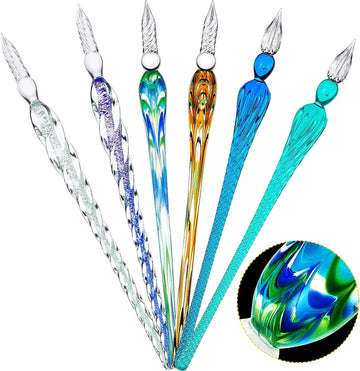Introduction
Dip pens, also known as nib pens, are classic writing and drawing tools that have been used for centuries. Unlike modern fountain pens or ballpoints, dip pens require frequent dipping into ink, offering a unique and customizable experience. Whether you're a calligrapher, artist, or just curious about traditional writing tools, this guide will walk you through everything you need to know about dip pens.
What is a Dip Pen?
A dip pen consists of two main parts:
- 1.The Holder (Pen Handle) – Usually made of wood, plastic, or metal, it holds the nib securely in place.
- 2.The Nib (Metal Tip) – A removable, pointed metal piece that holds and transfers ink to paper.
Unlike fountain pens, dip pens do not have an internal ink reservoir. Instead, you dip the nib into ink as needed, making them ideal for artistic and precise work.

Types of Dip Pen Nibs
Nibs come in various shapes and flexibility levels, each suited for different purposes:
1. Round Nibs (General Writing & Drawing)
- Best for: Beginners, everyday writing, sketching.
- Characteristics: Smooth, rounded tip for consistent ink flow.
- Examples: Brause Steno, Speedball #512.
2. Pointed Nibs (Flexible Calligraphy & Art)
- Best for: Copperplate, Spencerian script, expressive line work.
- Characteristics: Flexible tines that spread under pressure, creating thick and thin strokes.
- Examples: Nikko G, Zebra G, Leonardt Principal EF.
3. Italic/Broad Nibs (Broad-Edge Calligraphy)
- Best for: Gothic, Italic, and Blackletter calligraphy.
- Characteristics: Flat edge for uniform line width.
- Examples: Brause Bandzug, Speedball C-Series.
4. Mapping & Drawing Nibs (Technical Work)
- Best for: Drafting, technical drawing, fine details.
- Characteristics: Ultra-fine, rigid tips for precision.
- Examples: Hunt 102, Gillott 290.
5. Poster Nibs (Bold Lettering & Signage)
- Best for: Large lettering, posters, sign painting.
- Characteristics: Wide, flat tips for thick strokes.
- Examples: Speedball B-Series, Hiro Poster Nib.
Why Use a Dip Pen?
1. Superior Line Variation
- Unlike ballpoints or gel pens, dip pens allow for dramatic thick-and-thin strokes, essential for calligraphy and expressive art.
2. Customizable Ink Choices
- You can use any ink (India ink, acrylic, fountain pen ink, etc.), unlike fountain pens that require specific formulations.
3. Cost-Effective & Long-Lasting
- Nibs are inexpensive and replaceable, while holders can last a lifetime.
4. Ideal for Art & Calligraphy
- Many professional illustrators and calligraphers prefer dip pens for their precision and control.
5. Eco-Friendly
- No disposable plastic cartridges—just refillable ink bottles.
How to Use a Dip Pen
Step 1: Assemble Your Pen
- Insert the nib into the holder, ensuring it fits snugly. Some nibs may need a slight bend to stay secure.
Step 2: Prepare the Ink
- Use a small inkwell or bottle. Avoid dipping too deep—just cover the nib’s vent hole.
Step 3: Dip & Test
- Dip the nib, shake off excess ink, and test on scrap paper to check flow.
Step 4: Write or Draw
- Hold the pen at a 45-degree angle for smooth ink flow. Apply light pressure for thin lines, more pressure for thick strokes.
Step 5: Clean & Store Properly
- Wipe the nib with a damp cloth after use to prevent ink buildup. Store in a dry place to avoid rust.
FAQs About Dip Pens
1. Can I use fountain pen ink with a dip pen?
Yes, but it may be too thin and dry quickly. India ink or calligraphy ink works best.
2. Why does my dip pen skip or blot?
- The nib may have oil residue (clean with rubbing alcohol).
- You may be pressing too hard or holding the pen incorrectly.
3. How often should I dip the pen?
Every 3-5 words, depending on nib size and ink consistency.
4. Do dip pens work on all paper?
No—they work best on smooth, high-quality paper to prevent feathering.
5. Can left-handed people use dip pens?
Yes! Left-handed calligraphers may need to adjust paper angle to avoid smudging.
Final Thoughts
Dip pens offer a unique, hands-on writing and drawing experience unmatched by modern pens. While they require practice, the control and artistic possibilities make them worth the effort. Whether you're into calligraphy, illustration, or just love vintage tools, a dip pen is a fantastic addition to your creative toolkit.
Ready to try? Grab a basic nib set, some ink, and start experimenting!





